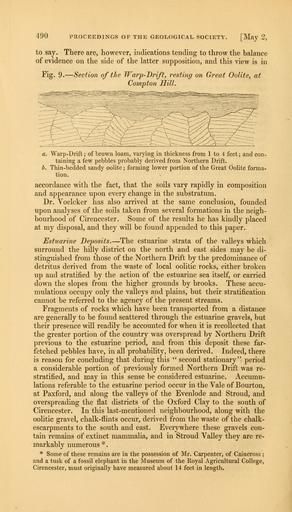MAKE A MEME
View Large Image

| View Original: | The_Quarterly_journal_of_the_Geological_Society_of_London_(12711584245).jpg (1828x3200) | |||
| Download: | Original | Medium | Small | Thumb |
| Courtesy of: | commons.wikimedia.org | More Like This | ||
| Keywords: The Quarterly journal of the Geological Society of London (12711584245).jpg 490 <br> PROCEEDINGS OF THE GEOLOGICAL SOCIETY May 2 <br> to say There are however mdications tending to throw the balance <br> of evidence on the side of the latter supposition and this view is in <br> Fig 9 ” Section of the Warp-Drift resting on Great Oolite at <br> Compton Hill <br> a Warp-Drift ; of brown loam varying in thickness from 1 to 4 feet ; and con- <br> taining a few pebbles probably derived from Northern Drift <br> b Thin-bedded sandy oolite ; forming lower portion of the Great Oolite forma- <br> tion <br> accordance with the fact that the soils vary rapidly in composition <br> and appearance upon every change in the substratum <br> Dr Voelcker has also arrived at the same conclusion founded <br> upon analyses of the soils taken from several formations in the neigh- <br> bourhood of Cirencester Some of the results he has kindly placed <br> at my disposal and they will be found appended to this paper <br> Estuarine Deposits ” The estuarine strata of the valleys which <br> surround the hilly district on the north and east sides may be di- <br> stinguished from those of the Northern Drift by the predominance of <br> detritus derived from the waste of local oolitic rocks either broken <br> up and stratified by the action of the estuarine sea itself or carried <br> down the slopes from the higher grounds by brooks These accu- <br> mulations occupy only the valleys and plains but their stratification <br> cannot be referred to the agency of the present streams <br> Fragments of rocks which have been transported from a distance <br> are generally to be found scattered through the estuarine gravels but <br> their presence will readily be accounted for when it is recollected that <br> the greater portion of the country was overspread by Northern Drift <br> previous to the estuarine period and from this deposit these far- <br> fetched pebbles have in all probability been derived Indeed there <br> is reason for concluding that during this ' second stationary period <br> a considerable portion of pre\iously formed Northern Drift was re- <br> stratified and may in this sense be considered estuarine Accumu- <br> lations referable to the estuarine period occur in the Vale of Bourton <br> at Paxford and along the valleys of the Evenlode and Stroud and <br> overspreading the flat districts of the Oxford Clay to the south of <br> Cirencester In this last-mentioned neighbourhood along with the <br> oolitic gravel chalk-flints occur derived from the waste of the chalk- <br> escarpments to the south and east Everywhere these gravels con- <br> tain remains of extinct mammalia and in Stroud Valley they are re- <br> markably numerous <br> Some of these remains are in the possession of Mr Carpenter of Caincross ; <br> and a tusk of a fossU elephant in the Museum of the Royal Agricultural College <br> Cirencester must originally have measured about 14 feet in length 35615092 110213 51125 Page 490 Text v 11 http //www biodiversitylibrary org/page/35615092 1855 Geological Society of London Biodiversity Heritage Library The Quarterly journal of the Geological Society of London v 11 1855 Geology Periodicals Smithsonian Libraries bhl page 35615092 dc identifier http //biodiversitylibrary org/page/35615092 smithsonian libraries Information field Flickr posted date ISOdate 2014-02-23 Check categories 2015 August 26 CC-BY-2 0 BioDivLibrary https //flickr com/photos/61021753 N02/12711584245 2015-08-26 21 01 33 cc-by-2 0 PD-old-70-1923 The Quarterly journal of the Geological Society of London 1855 Photos uploaded from Flickr by Fæ using a script | ||||